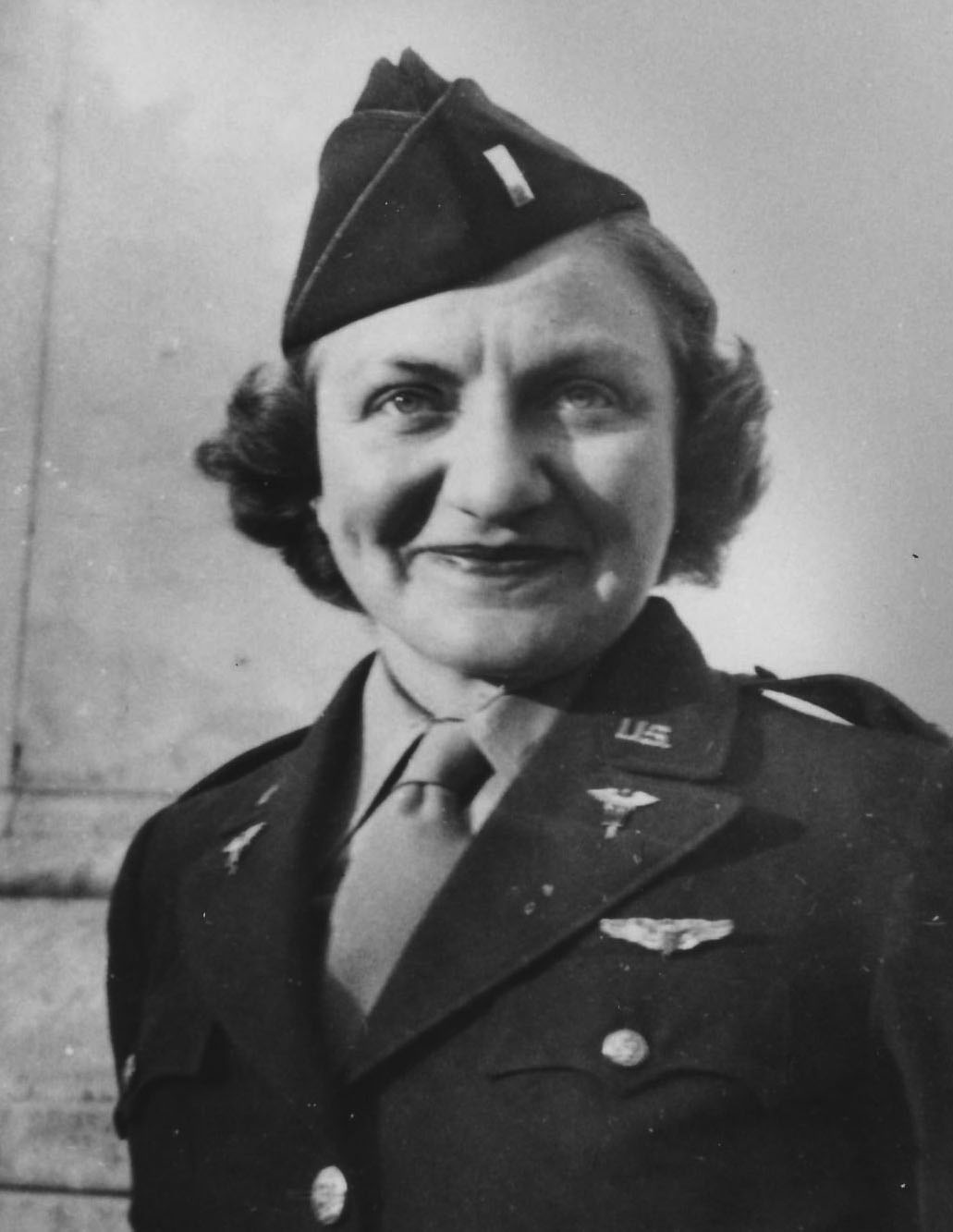Aleda Lutz was born in Freeland, Michigan in 1915. She graduated from the Saginaw General Hospital School of Nursing in 1937. Lutz volunteered for the Army Nurse Corps in 1942. Initial assignment was at the Selfridge Field station hospital in Mount Clemens, Michigan.
She then became an Air Evacuation Nurse with the 802nd Medical Air Evacuation Squadron, 12th Air Force. The unit deployed to North Africa, where Aleda participated in six campaigns over a 20-month period. She conducted all-weather medical evacuations in France, Italy, and Tunisia. She died at age 28 near Saint-Chamond, France, on November 1, 1944, when her flight crashed with no survivors, Lutz was the first American woman to die during World War II.
She was the most experienced flight nurse in the US military service, with 814 flight-nurse combat hours. She flew 196 missions and evacuated over 3,500 men during World War II. That was at the dawn of aeromedical flights. On November 1, 1944, the C-47 hospital plane evacuating wounded soldiers from the battlefront near Lyons, Italy, crashed killing all on board as a result of a storm.
On December 28, 1944, she was posthumously awarded the Distinguished Flying Cross. She was the first woman to be awarded the medal in war. She has been inducted into the Michigan Military and Veterans Hall of Honor in 2020 and in 1990 the Veterans Affairs Medical Center in Saginaw, Michigan was named after Lt. Lutz. Additionally, an Army hospital ship has been named in her honor. The National Museum of the United States Army elaborated on the life of Lutz, “Aleda Lutz, known as ‘Lutzy’ by her friends, was a small-town woman with big dreams.”
Aleda Ester Lutz was born on November 9, 1915, and grew up in Freeland, Michigan as the youngest of 10 children. She went on to be the only child in her family to graduate high school, graduating from Arthur Hill High School in 1933. She earned a degree in nursing from Saginaw General Hospital of Nursing (now Covenant HealthCare) in 1937. In 1940, at only 25, she worked as a nurse at a private practice, living in a boarding house with her sister Hulda. After the start of World War II, she realized she wanted to put her skills to good use. Three of her brothers had served in the U.S. military during both World Wars. She decided to uphold her family’s legacy of military service and enlisted in the Army Nurse Corps in February 1942.
As the child of German immigrants, Lutz grew up bilingual which was an asset to the Army. Her military career began at the Station Hospital at Selfridge Field, located in Mount Clemens, Michigan (now Selfridge Air National Guard Base); there, she served as a general duty nurse, managing around 25 patients on her own. Once she completed basic training, she volunteered for the flight nurse program; these women provided care to the sick and wounded via air evacuation missions. She took the required pilot physical test and became one of only three women to pass. Lutz was promoted to first lieutenant and joined the 802d Medical Air Evacuation Squadron (MAES) in the Army’s 12th Air Force, the first team of flight nurses to deploy overseas.
The Army activated the 507th Air Evacuation Squad in October of 1942 and, with the 349th Air Evacuation Group, formed the Army Air Forces School of Air Evacuation in June 1943. Historian Mary Sarnecky described these trailblazing women and noted that “as volunteers, they underwent rigorous training and endured harrowing experiences.” Besides passing rigorous physical tests and enduring various training, all flight nurses adhered to several restrictions, including age and weight. They had to be between the ages of 21 and 36, weight between 105 and 135 pounds, and measure between 62 and 72 inches in height. After they passed the pilot physical test, they underwent instruction in nursing, survival skills, chemical warfare, and detecting booby traps.
Flight nurse responsibilities included evacuating Soldiers from war zones by medical planes. These planes doubled as cargo vehicles and therefore were not marked with a red cross. This put them at increased risk of enemy fire. The women ensured the Soldiers remained medically stable throughout the flight. They also taught Soldiers best practices for transporting wounded on and off the planes. The “Flying Florence Nightingales” were the key to evacuating wounded Soldiers in a quick and efficient manner. Nurses in this program held much more autonomy than a standard nurse since flight nurses were in charge on these air evacuations. There were no doctors, so surgery was avoided, but flight nurses prioritized which injured Soldiers could survive the flight evacuation. Only 46 of the 1,176,048 patients that were evacuated by air died en route.
She received numerous awards, including the Distinguished Flying Cross, Air Medal with four Oak Leaf clusters, European-African-Middle Eastern Campaign Medal, Red Cross Medal, and Purple Heart. Her home state of Michigan posthumously presented her with induction into the Saginaw Hall of Fame in 1979, the Michigan Women’s Hall of Fame in 1994, and the Michigan Aviation Hall of Fame in 2010. Many facilities were named after her including the Aleda E. Lutz Department of Veterans Affairs Medical Center in Saginaw, Michigan, a former troopship turned hospital ship, and a C-47.
Lutz, with the other deceased from that fatal flight, is buried in northern France. There is now a monument at the St.Chaumon crash site in remembrance of those who lost their lives. The plaque is fused to a large stone that has been placed at the site of the crash in remembrance. The plaque, written in French, roughly translates to:
“To the memory of the five American Dakota crew members and the fifteen Allied and German wounded soldiers who died in the crash of November 1, 1944. Under the responsibility of Nurse Lieutenant Aleda E. Lutz DFC who was the first military woman to be operational during the Second World War.”
Aldea Lutz was a trailblazer. She proved it did not matter where you grew up or where you received your training. She demonstrated the value to wounded soldiers of a dedicated and compassionate nurse. Her efforts, joined with others, proved the worth of aeromedical flight and that has led to thousands of flight nurses saving countless thousands of lives.

